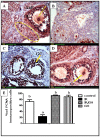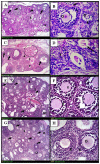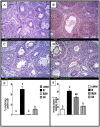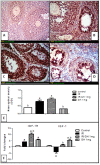Growth Hormone Ameliorates the Radiotherapy-Induced Ovarian Follicular Loss in Rats: Impact on Oxidative Stress, Apoptosis and IGF-1/IGF-1R Axis
- PMID: 26465611
- PMCID: PMC4605641
- DOI: 10.1371/journal.pone.0140055
Growth Hormone Ameliorates the Radiotherapy-Induced Ovarian Follicular Loss in Rats: Impact on Oxidative Stress, Apoptosis and IGF-1/IGF-1R Axis
Abstract
Radiotherapy is one of the standard cytotoxic therapies for cancer. However, it has a profound impact on ovarian function leading to premature ovarian failure and infertility. Since none of the currently available methods for fertility preservation guarantees future fertility, the need for an effective radioprotective agent is highly intensified. The present study investigated the mechanisms of the potential radioprotective effect of growth hormone (GH) on γ irradiation-induced ovarian failure and the impact of the insulin like growth factor 1 (IGF-1) in the underlying protection. Immature female Sprague-Dawley rats were either exposed to single whole body irradiation (3.2 Gy) and/or treated with GH (1 mg/kg s.c). Experimental γ-irradiation produced an array of ovarian dysfunction that was evident by assessment of hormonal changes, follicular development, proliferation marker (PCNA), oxidative stress as well as apoptotic markers. In addition, IGF-1/IGF-1R axis expression was assessed using real-time PCR and immunolocalization techniques. Furthermore, after full maturity, fertility assessment was performed. GH significantly enhanced follicular development and restored anti-Mullerian hormone serum level as compared with the irradiated group. In addition, GH significantly ameliorated the deleterious effects of irradiation on oxidative status, PCNA and apoptosis. Interestingly, GH was shown to enhance the ovarian IGF-1 at transcription and translation levels, a property that contributes significantly to its radioprotective effect. Finally, GH regained the fertility that was lost following irradiation. In conclusion, GH showed a radioprotective effect and rescued the ovarian reserve through increasing local IGF-1 level and counteracting the oxidative stress-mediated apoptosis.
Conflict of interest statement
Figures






Similar articles
-
Carvacrol and Thymol Modulate the Cross-Talk between TNF-α and IGF-1 Signaling in Radiotherapy-Induced Ovarian Failure.Oxid Med Cell Longev. 2019 Aug 20;2019:3173745. doi: 10.1155/2019/3173745. eCollection 2019. Oxid Med Cell Longev. 2019. PMID: 31531182 Free PMC article.
-
Insights into the protective mechanisms of tamoxifen in radiotherapy-induced ovarian follicular loss: impact on insulin-like growth factor 1.Endocrinology. 2013 Oct;154(10):3888-99. doi: 10.1210/en.2013-1214. Epub 2013 Jun 24. Endocrinology. 2013. PMID: 23798597
-
Sodium selenite improves folliculogenesis in radiation-induced ovarian failure: a mechanistic approach.PLoS One. 2012;7(12):e50928. doi: 10.1371/journal.pone.0050928. Epub 2012 Dec 6. PLoS One. 2012. PMID: 23236409 Free PMC article.
-
Involvement of growth hormone (GH) and insulin-like growth factor (IGF) system in ovarian folliculogenesis.Theriogenology. 2009 May;71(8):1193-208. doi: 10.1016/j.theriogenology.2008.12.015. Epub 2009 Feb 3. Theriogenology. 2009. PMID: 19193432 Review.
-
Impact of growth hormone hypersecretion on the adult human kidney.Ann Endocrinol (Paris). 2011 Dec;72(6):485-95. doi: 10.1016/j.ando.2011.08.001. Epub 2011 Nov 17. Ann Endocrinol (Paris). 2011. PMID: 22098791 Review.
Cited by
-
Dual Characters of GH-IGF1 Signaling Pathways in Radiotherapy and Post-radiotherapy Repair of Cancers.Front Cell Dev Biol. 2021 Jun 9;9:671247. doi: 10.3389/fcell.2021.671247. eCollection 2021. Front Cell Dev Biol. 2021. PMID: 34178997 Free PMC article. Review.
-
Combating radiation therapy-induced damage to the ovarian environment.Future Oncol. 2016 Jul;12(14):1687-90. doi: 10.2217/fon-2016-0121. Epub 2016 Apr 27. Future Oncol. 2016. PMID: 27117319 Free PMC article. Review. No abstract available.
-
Carvacrol and Thymol Modulate the Cross-Talk between TNF-α and IGF-1 Signaling in Radiotherapy-Induced Ovarian Failure.Oxid Med Cell Longev. 2019 Aug 20;2019:3173745. doi: 10.1155/2019/3173745. eCollection 2019. Oxid Med Cell Longev. 2019. PMID: 31531182 Free PMC article.
-
Hsa-let-7c controls the committed differentiation of IGF-1-treated mesenchymal stem cells derived from dental pulps by targeting IGF-1R via the MAPK pathways.Exp Mol Med. 2018 Apr 13;50(4):1-14. doi: 10.1038/s12276-018-0048-7. Exp Mol Med. 2018. PMID: 29650947 Free PMC article.
-
Butylphthalide identified via Samul-tang-induced transcriptomic signatures improves oocyte quality in aged mice.NPJ Aging. 2025 Mar 26;11(1):21. doi: 10.1038/s41514-025-00214-3. NPJ Aging. 2025. PMID: 40140401 Free PMC article.
References
-
- Steel GG. Basic clinical radiobiology (3rdedn.), Edward Arnold Publishers; London; 2002.
-
- Nair CK, Parida DK, Nomura T. Radioprotectors in radiotherapy. J Radiat Res. 2001; 42(1): 21–37. - PubMed
-
- Meirow D. Reproduction post-chemotherapy in young cancer patients. Mol Cell Endocrinol. 2000; 169, 123–131. - PubMed
-
- Pacey AA. Fertility issues in survivors from adolescent cancers. Cancer Treat Rev. 2007; 33:646–655. - PubMed
MeSH terms
Substances
LinkOut - more resources
Full Text Sources
Other Literature Sources
Miscellaneous

